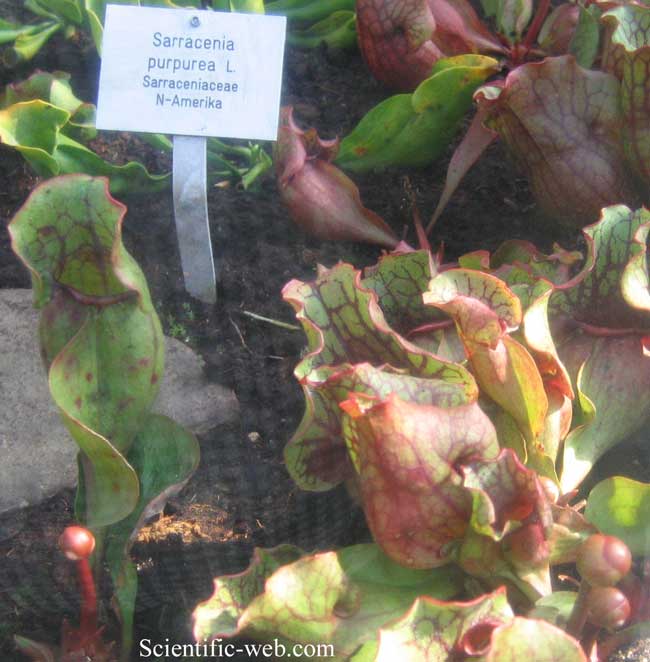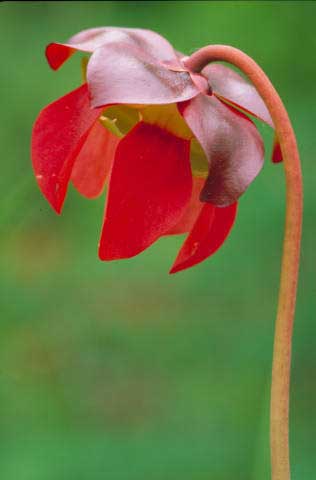
Sarracenia purpurea, Photo: Michael Lahanas
Classification System: APG IV
Superregnum: Eukaryota
Regnum: Plantae
Cladus: Angiosperms
Cladus: Eudicots
Cladus: Core eudicots
Cladus: Asterids
Ordo: Ericales
Familia: Sarraceniaceae
Genus: Sarracenia
Species: Sarracenia purpurea
Name
Sarracenia purpurea L.

Sarracenia purpurea, Photo: U.S. Fish and Wildlife Service
References
Linnaeus, C. 1753. Species Plantarum. Tomus I: 510. Reference page.
McPherson, S. 2007. Pitcher Plants of the Americas. - The McDonald & Woodward Publishing Company.
Schnell, D. E. 1976. Carnivorous Plants of the United States and Canada. - John F. Blair.
Miller, K. M. and Kneitel, J. M. 2005. Inquiline communities in pitcher plants as a prototypical metacommunity. - In: Holyoak, M., Leibold, M. A. and Holt, R. D. (eds.), Metacommunities: Spatial Dynamics and Ecological Communities. University of Chicago Press, pp. 122-145.
Hoekman, D. 2007. Top-down and bottom-up regulation in a detritus-based aquatic food web: a repeated field experiment using the pitcher plant (Sarracenia purpurea) inquiline community. - American Midland Naturalist 157: 52–62.
Vernacular names
Deutsch: Rote Schlauchpflanze
English: Purple Pitcher-plant
suomi: Purppuratötterö, tötterölehti
français: Sarracénie pourpre
Nederlands: Paarse trompetbekerplant
română: Cănişoară
svenska: Flugtrumpet
中文: 紫瓶子草
Sarracenia purpurea, the purple pitcher plant, northern pitcher plant, turtle socks, or side-saddle flower, is a carnivorous plant in the family Sarraceniaceae.
Description
Like other species of Sarracenia, S. purpurea obtains most of its nutrients through prey capture.[1] However, prey acquisition is said to be inefficient, with less than 1% of the visiting prey captured within the pitcher.[2] Even so, anecdotal evidence by growers often shows that pitchers quickly fill up with prey during the warm summer months. Prey fall into the pitcher and drown in the rainwater that collects in the base of each leaf.
Prey items, such as flies, ants, spiders, and even moths or hornets, are then digested by an invertebrate community, made up mostly by the mosquito Wyeomyia smithii and the midge Metriocnemus knabi. The relationship between W. smithii and S. purpurea is an example of commensalism.[3]
Oldest known illustration of Sarracenia purpurea, from Clusius's Rariorum plantarum historia, cf. 18, 1601
Seeds
S. purpurea also traps juvenile spotted salamanders with enough regularity that nearly 20% of surveyed plants were found to contain one or more salamanders in a 2019 study. The salamanders were observed to die within three to nineteen days, and may be killed as the small pools of water in the plant are heated by the sun. A single salamander could provide hundreds to thousands of times the nutrients of invertebrate prey, but it is not known how efficiently S. purpurea is able to digest them.[4]
Protists, rotifers (including Habrotrocha rosa), and bacteria form the base of inquiline food web that shreds and mineralizes available prey, making nutrients available to the plant.[5][6][7] New pitcher leaves do produce digestive enzymes such as hydrolases and proteases, but as the individual leaves get older into their second year, digestion of prey material is aided by the community of bacteria that live within the pitchers.[8][9]
Pitchers
Flowers
Distribution
Its range includes the Eastern seaboard, the Great Lakes region, all of Canada (except Nunavut and Yukon), Washington state, and Alaska.[10] That makes it the most common and broadly distributed pitcher plant, as well as the only member of the genus that inhabits cold temperate climates. It is endangered or vulnerable over much of the southern part of its range.[11] The species is the floral emblem of the Canadian province of Newfoundland and Labrador. Most varieties along the Gulf Coast of the United States that were once identified as Sarracenia purpurea have since been reclassified as Sarracenia rosea.
It is an introduced and naturalized species in Europe and the northwestern US.[12] It is found in habitats of the native carnivorous species Darlingtonia californica, in the Klamath Mountains and northern Sierra Nevada.[13] The plant has also been recorded in Washington state, Austria, the Czech Republic, Denmark, France, Germany, Ireland, Sweden, Switzerland, and the United Kingdom.[12][14] In Britain and Ireland purple pitcher plant have invaded heather-rich peatbogs in Britain and Ireland and with the mild climate can grow in large numbers at the expense of local flora. Peatbogs are also under threat as the Sphagnum mosses do not grow near the pitcher plant.[15][16]
Taxonomy
The species is further divided into two subspecies, S. purpurea subsp. purpurea and S. purpurea subsp. venosa. The former is found from New Jersey north, while the latter is found from New Jersey south and tolerates warmer temperatures.
In 1999, Sarracenia purpurea subsp. venosa var. burkii was described as a species of its own: Sarracenia rosea. This re-ranking has been debated among carnivorous plant enthusiasts since then, but further morphological evidence has supported the split.[17] The following species and infraspecific taxa are usually recognized:
Sarracenia purpurea subsp. purpurea
Sarracenia purpurea subsp. purpurea f. heterophylla
Sarracenia purpurea subsp. purpurea f. ruplicola (invalid)
Sarracenia purpurea subsp. venosa
Sarracenia purpurea subsp. venosa var. burkii [=S. rosea]
Sarracenia purpurea subsp. venosa var. burkii f. luteola[18]
Sarracenia purpurea subsp. venosa var. montana
Uses
Ornamental
Sarracenia purpurea is cultivated as an ornamental plant. It is fairly hardy, but requires a reliably damp soil in a sheltered position, with full or partial sunlight. The subspecies S. purpurea ssp. purpurea has received the Royal Horticultural Society's Award of Garden Merit.[19]
Medicinal
It was used as a medicinal plant by Native American and First Nation tribes in its northeastern and Great Lakes distribution ranges, including the Algonquin, Cree, Iroquois, Mi'kmaq (Micmac) peoples,[20] primarily for use in treating smallpox by means of a root infusion.[21] A 2012 study suggests Sarracenia purpurea is effective as a treatment for viruses in the Orthopoxvirus family, including the smallpox virus, through inhibition of early virus transcription. [22]
Biocontrol
Sarracenia purpurea pitchers have been investigated as a biocontrol for the Asian Hornet Vespa velutina in Europe,[23] as they act as natural bottle traps in which hornets have been observed to be trapped in. The hybrids used in the study, S. juthatipsoper and S. evendine, were deemed too unselective, but the researchers proposed trying other pitcher plant species which may be more effective.[24][25]
References
Wakefield AE; Gotelli NJ; Wittman SE; Ellison AM (2005). "Prey addition alters nutrient stoichiometry of the carnivorous plant Sarracenia purpurea". Ecology (abstract). 86 (7): 1737–1743. doi:10.1890/04-1673.
Newell SJ; Nastase AJ (1998). "Efficiency of nutrient capture by Sarracenia purpurea (Sarraceniaceae), the Northern Pitcher Plant". American Journal of Botany. 85 (1): 88–91. doi:10.2307/2446558. JSTOR 2446558. S2CID 16021826.
C. Michael Hogan. 2011. Commensalism. Topic Ed. M.Mcginley. Ed-in-chief C.J.Cleveland. Encyclopedia of Earth. National Council for Science and the Environment. Washington DC
Ceurstemont, Sandrine (2019), Carnivorous plants eat far more salamanders than scientists thought, National Geographic, retrieved 31 January 2021
Heard SB (1994). "Pitcher plant midges and mosquitoes: a processing chain commensalism". Ecology (abstract). 75 (6): 1647–1660. doi:10.2307/1939625. JSTOR 1939625.
Mouquet N.; Daufresne T.; Gray S. M.; Miller T. E. (2008). "Modelling the relationship between a pitcher plant (Sarracenia purpurea) and its phytotelma community: mutualism or parasitism?". Functional Ecology. 22 (4): 728–737. doi:10.1111/j.1365-2435.2008.01421.x.
Peterson C. N.; Day S.; Wolfe B. E.; Ellison A. M.; Kolter R.; Pringle A. (2008). "A keystone predator controls bacterial diversity in the pitcher-plant (Sarracenia purpurea) microecosystem". Environmental Microbiology. 10 (9): 2257–2266. doi:10.1111/j.1462-2920.2008.01648.x. PMID 18479443.
Rice, Barry. (2007). About Sarracenia purpurea, the purple pitcher plant. The Carnivorous Plant FAQ. Accessed online: 21 June 2008.
Gallie D. R.; Chang S.-C. (1997). "Signal transduction in the carnivorous plant Sarracenia purpurea. Regulation of secretory hydrolase expression during development and in response to resources". Plant Physiology. 115 (4): 1461–1471. doi:10.1104/pp.115.4.1461. PMC 158611. PMID 9414556.
USDA Distribution map of Sarracenia purpurea
"NatureServe Explorer 2.0".
"Sarracenia purpurea". EPPO (European and Mediterranean Plant Protection Organization). Retrieved 2021-07-08.
Jepson Manual eFlora (TJM2) treatment of Sarracenia purpurea − naturalized distribution in California
"Sarracenia purpurea L." Kewscience. Plants of the World online. Retrieved 14 January 2021.
Agyepong-Parsons, James (January 2021). "Suck Stick Drip". BBC Wildlife. pp. 32–5.
Foss, P.J. & O'Connell, C.A. (1985). "Notes on the ecology of Sarracenia purpurea L. on Irish peatlands". The Irish Naturalists' Journal. 21 (10): 440–443. JSTOR 25538921.
Ellison A. M.; Buckley H. L.; Miller T. E.; Gotelli N. J. (2004). "Morphological variation in Sarracenia purpurea (Sarraceniaceae): geographic, environmental, and taxonomic correlates" (PDF). American Journal of Botany. 91 (11): 1930–1935. doi:10.3732/ajb.91.11.1930. PMID 21652339.
Hanrahan B.; Miller J. (1998). "History of Discovery: Yellow Flowered Sarracenia purpurea L. subsp. venosa (Raf.) Wherry var. burkii". Carnivorous Plant Newsletter. 27 (1): 14–17.
"Sarracenia purpurea subsp. purpurea". RHS. Retrieved 5 March 2021.
Native American Ethnobotany DB: Sarracenia purpurea L. Documented uses.
Charles Frederick Millspaugh (1892). American Medicinal Plants: An Illustrated and Descriptive Guide to Plants Indigenous to and Naturalized in the United States which are Used in Medicine (illustrated ed.). Courier Corporation. p. 76. ISBN 9780486230344.
Arndt, William; Mitnik, Chandra; Denzler, Karen L.; White, Stacy; Waters, Robert; Jacobs, Bertram L.; Rochon, Yvan; Olson, Victoria A.; Damon, Inger K.; Langland, Jeffrey O. (2012-03-09). "In Vitro Characterization of a Nineteenth-Century Therapy for Smallpox". PLOS ONE. 7 (3): e32610. Bibcode:2012PLoSO...732610A. doi:10.1371/journal.pone.0032610. ISSN 1932-6203. PMC 3302891. PMID 22427855.
Corentin Dupont. "Variation in colour signals among Sarracenia pitcher plants and the potential role of areoles in the attraction of flying Hymenoptera". biorxiv.org. AMAP, University, Montpellier. Retrieved 27 March 2022.
"Wycke M-A, Perrocheau R, Darrouzet E (2018) Sarracenia carnivorous plants cannot serve as efficient biological control of the invasive hornet Vespa velutina nigrithorax in Europe. Rethinking Ecology 3: 41-50. DOI 10.3897/rethinkingecology.3.28516". Rethinking Ecology. 3: 41–50. 11 December 2018. doi:10.3897/rethinkingecology.3.28516.
"Can carnivorous plants control an invasive hornet?". 20 November 2018.
Retrieved from "http://en.wikipedia.org/"
All text is available under the terms of the GNU Free Documentation License

